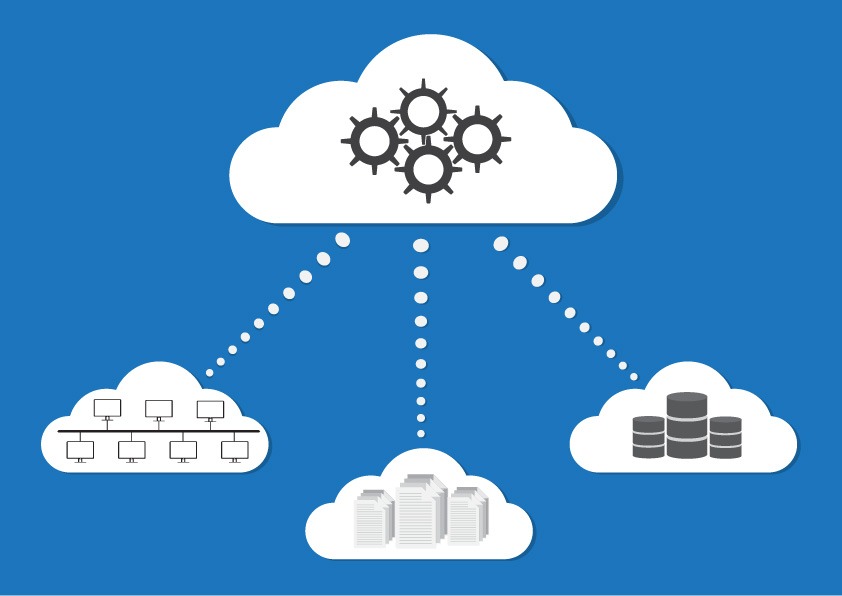cloud solution
Challenges are a part of everyday business for all organisations. One of the best way to overcome the challenges of business and technology is through cloud computing solutions providers.

Private Cloud Solutions
A private cloud is a particular model of cloud computing that involves a distinct and secure cloud based environment in which only the specified client can operate.As with other cloud models, private clouds will provide computing power as a service within a virtualised environment using an underlying pool of physical computing resource. However, under the private cloud model, the cloud (the pool of resource) is only accessible by a single organisation, therefore providing that organisation with greater control and privacy.
The public model offers the following features and benefits
✓ HIGHER SECURITY AND PRIVACY
While public cloud services offer a certain level of security, private clouds are the more secure option. This is achieved using distinct pools of resource with access restricted to connections made from one organisation’s firewall, dedicated leased lines and on-site internal hosting
✓ MORE CONTROL
As a private cloud is only accessible by a single organisation, that organisation will have the ability to configure and manage it inline with their needs to achieve a tailored network solution
✓ COST AND ENERGY EFFICIENCY
Implementing a private cloud model can improve the allocation of resources within an organisation by ensuring that the availability of resources to individual departments/business functions can directly and flexibly respond to their demand. They make more efficient use of the computing resource than traditional LANs and can also reduce an organisation’s carbon footprint
✓ IMPROVED RELIABILITY
Even where resources (servers, networks etc.) are hosted internally, the creation of virtualised operating environments means that the network is more resilient to individual failures across the physical infrastructure. Virtual partitions can, for example, pull their resource from the remaining unaffected servers
✓ CLOUD BURSTING
Some providers may offer the opportunity to employ cloud bursting, within a private cloud offering, in the event of spikes in demand. This service allows the provider to switch certain non-sensitive functions to a public cloud to free up more space in the private cloud for the sensitive functions that require
Public Cloud Solutions
The most recognizable model of cloud computing to many consumers is the public cloud model, under which cloud services are provided in a virtualized environment, constructed using pooled shared physical resources, and accessible over a public network such as the internet. To some extent they can be defined in contrast to private clouds which ring-fence the pool of underlying computing resources, creating a distinct cloud platform to which only a single organization has access. Public clouds, however, provide services to multiple clients using the same shared infrastructure. The most salient examples of cloud computing tend to fall into the public cloud model because they are, by definition, publicly available. Software as a Service (SaaS) offerings such as cloud storage and online office applications are perhaps the most familiar, but widely available Infrastructure as a Service (IaaS) and Platform as a Service (PaaS) offerings, including cloud based web hosting and development environments, can follow the model as well (although all can also exist within private clouds). Public clouds are used extensively in offerings for private individuals who are less likely to need the level of infrastructure and security offered by private clouds. However, enterprise can still utilise public clouds to make their operations significantly more efficient, for example, with the storage of non-sensitive content, online document collaboration and webmail. The public model offers the following features and benefits:

✓ Ultimate scalability; cloud resources are available on demand from the public clouds’ vast pools of resource so that the applications that run on them can respond seamlessly to fluctuations in activity
✓ Cost effective; public clouds bring together greater levels of resource and so can benefit from the largest economies of scale. The centralised operation and management of the underlying resources is shared across all of the subsequent cloud services whilst components, such as servers, require less bespoke configuration. Some mass market propositions can even be free to the client, relying on advertising for their revenue.
✓ Utility style costing; public cloud services often employ a pay-as-you-go charging model whereby the consumer will be able to access the resource they need, when they need it, and then only pay for what they use; therefore avoiding wasted capacity
✓ Reliability; the sheer number of servers and networks involved in creating a public cloud and the redundancy configurations mean that should one physical component fail, the cloud service would still run unaffected on the remaining components. In some cases, where clouds draw resource from multiple data centres, an entire data centre could go offline and individual cloud services would suffer no ill effect. There is, in other words, no single point of failure which would make a public cloud service vulnerable
✓ Flexibility; there are a myriad of IaaS, PaaS and SaaS services available on the market which follow the public cloud model and that are ready to be accessed as a service from any internet enabled device. These services can fulfil most computing requirements and can deliver their benefits to private and enterprise clients alike. Businesses can even integrate their public cloud services with private clouds, where they need to perform sensitive business functions, to create hybrid clouds
✓ Location independence; the availability of public cloud services through an internet connection ensures that the services are available wherever the client is located. This provides invaluable opportunities to enterprise such as remote access to IT infrastructure (in case of emergencies etc) or online document collaboration from multiple locations.

Hybrid Cloud Solutions
A hybrid cloud is where dedicated (physical) servers and network equipment, possibly an existing collocated IT infrastructure, are integrated with a cloud hosting platform. Advantages of Hybrid Cloud services for your Business ✓ Maximize investment into existing or legacy IT infrastructure (use assets for longer)
✓ Achieve a best of both worlds solution using cloud & physical environments
✓ Allows for a phased physical to virtual migration process (P2V)
✓ Easily integrate legacy IT systems with new technology
✓ Use custom hardware devices with your cloud infrastructure
